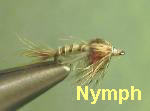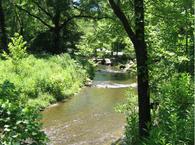Dun General Description:
The Quill Gordon duns have obvious heart shaped marks on their legs that make them easy to differentiate from the other mayflies. Other species may have the same type of mark but their hatch occurs at different times.
The Quill Gordon duns usually take some time to dry their wings while they linger for some time on the surface of the water. They will emerge from the slower moving water and they can be caught up in the stronger current. Therefore, they may be drifting downstream on the surface of the water longer than some other mayflies, making them more vulnerable for the trout to eat. This is dependent on the water temperature and conditions, for example, when the water temperature raises to 50 degrees F and above, and remaining there for some time, you will see the trout taking the duns on the surface. During these times, the dun patterns will work great.
If the trout does not take your dun during these times, they are simply not feeding on the surface and are most probably feeding on the emerging nymphs that are easier prey. In this case, it will make more sense to switch to a wet fly. Learn how to identify how the trout take flies as they take emergers differently than they take duns.
Dun Presentation:

When fishing the smooth edge of the current seams where the faster water meets the slower water or calm pocket in rough water use a straight up and down cast and mend the line if necessary. In other types of water, such as the ends of long slow runs, or the tails of pools, use a down and across presentation to get the desired drag free drift. Keep your casts short in order to keep your line out of the water as much as possible, to prevent drag. You will want your fly to drift naturally down the current seam where the trout will be feeding.
If you are working a long run, let your dry fly dun to drift all the way to the slower water at the end of the run, requiring a longer cast. Again like the Blue Quill, the duns can drift a long way, so keep your fly dry with good floating capacity. The trout taking these duns can easily be seen so that is helpful in locating them or the hatch.
Again, use stealth as you approach the stream from the bank and place your fly as delicately as possible. If you are wading, be very careful to approach from being a log or boulder, keeping a low profile.

See the new double sided fly boxes.
Bait/Lure Type:
Equipment:





